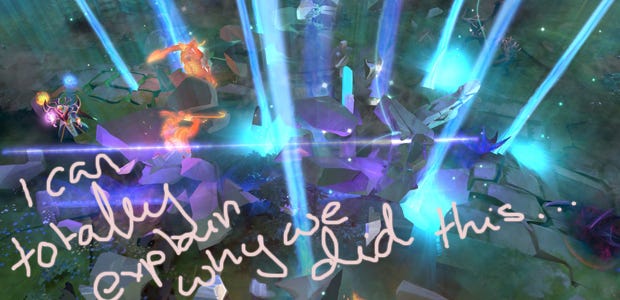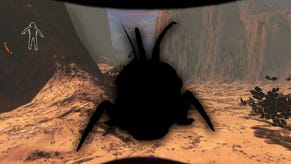Dote Night: Does Lore Matter To Online Wizard Fights?
The Long Arm Of The Lore
Part of a miscellany of serious thoughts, animal gifs, and anecdotage from the realm of MOBAs/hero brawlers/lane-pushers/ARTS/tactical wizard-em-ups. One day Pip might even tell you the story of how she bumped into Na'Vi's Dendi at a dessert buffet cart.
A few days back I was reading through Skeleton King's lore and picking over his evolution through the years. It pulled me into a wider train of thought about Dota lore and how the game itself doesn't go in for a particular obvious narrative conceit. You are a team of wizards – some of whom know each other – and you want to kick over the other team's base. What the base does, what the team does after winning or losing, why the characters are on Radiant or Dire side – none of that gets addressed over the course of a match. But why is that the case, and would Dota 2 benefit from a little more lore?
Dota 2 started life not as a Valve property but as a part of Blizzard's gaming scene. Not even in Warcraft 3 but StarCraft where a player-created map called Aeon of Strife ignored base building in favour of using a selection of hero units to push lanes against an enemy AI. This StarCraft map then got remade in Warcraft 3 using that game's assets as Defence of the Ancients. It was then maintained and tweaked over the years by the stewards of DotA and its popular variant, DotA: All Stars. Eventually Valve hired mod developer IceFrog and acquired the rights to produce Dota 2 (although the process was not without a spot of legal wrangling over the trademark 'Dota' and a heap of copyright-related tweaks).
The more you pick through the history and stories of Dota 2 the more it reminds me of a sprawling city. Over time it has changed shape, bits have been reworked, events have left a mark on the world, people have moved on – Eul, Guinsoo… – but their names remain known. The important lore in Dota for me and a lot of other people is this stuff – the bits that involve an aggregation of real gaming history and real people rather than storytelling. It's because a lot of it is very prominent in-game. You wonder why someone is calling Nature's Prophet Furion so you end up reading about Warcraft's Malfurion Stormrage. You have no idea why the sheepstick turns people into pigs so you look that up too. Then you add "why do these weirdos call a donkey 'the chick'?" to your search history.
(Sidenote: my search history also includes "what's so great about yachts?" "what the fuck is a salt pig?" and "best owls")
There is actually some real in-game lore which attempts to explain what you're doing with regard to protecting or destroying these Ancients. It's hidden away in the Archronicus; a collection of short stories you'll unlock in the tutorial section. The Mad Moon and the Ancients tells the story of warring ancient intelligences trapped in a glowing moon. Eventually the moon shatters and the shards which fall to earth turn out to have separated into either pure Radiant or pure Dire form. Those nearby become dependent on the shards' energy and develop strange powers. Eventually the influence of the shards spreads sufficiently that it encounters its opposite and causes conflict.
This lore was only added into the game very recently (although it was present on the developer forum over a year before that). It sits in the tutorial section so it seems to be almost entirely for the benefit of new players. But as someone who got to grips with Dota without any unifying or justifying lore, reading The Mad Moon and the Ancients feels a little odd. I got into this game about battling five other wizards across three lanes because there's a great deal of pleasure in the rhythms and interactions this map and those heroes create. Because it lets you show off skill and pick a preferred playstyle. Because it's video games-y as all hell. You get touches of lore in that some characters have dialogue lines specifically aimed at one another but it's a light touch and one I enjoy encountering.
Or rather it is once I'd sunk a certain amount of time into it. Dota is also obscure and inaccessible, with a steep difficulty curve. The jargon is so rooted in its own history it makes no sense. Why is someone shouting at you to "recrow" when what you're trying to do is summon a donkey? The popularity of the Newcomer Stream at TI4 speaks volumes about how difficult people find it to parse a match or follow the regular commentator dialogue. I've wondered whether similar games use a central conceit to help players out at all so I ended up digging into League of Legends lore too.
League didn't start life as a mod. It wasn't a weird rebuilding of a different user generated map using someone else's Lego so it was logical to start with a central, coherent idea rather than retrospectively apply one. (I should say that with League of Legends I watch and enjoy the pro scene but I don't play the game myself.) As it goes, the pro scene doesn't reference the lore beyond a few character interaction points so clearly it's not central to the enjoyment or understanding of the game, but the basic idea is that you play a neutral magician working on conflict resolution for the wizard UN.
The slightly longer version is that there were a couple of Rune wars which left the world in a sorry state. As a third war loomed the League of Legends was set up to prevent direct and catastrophic conflict and to mediate. Summoners (which is what the players are) are neutral forces in this but they mind meld with Champions who come from the various city states and control them in battle on the various Fields of Justice. These battles are used as part of the dispute resolution process and are also broadcast around the land as a kind of future sport – sort of rugby meets the wizard Hunger Games.
I've spoken to friends who play regularly and the general consensus is that none of that story is part of playing the game. It informs a few of the character interactions but you could play for thousands of hours and never know anything about the conflict situation in the land of Runeterra. Reading through all of it was interesting but the overall impression was that the lore was a remnant – a concept intended to head off any ludonarrative dissonance at the pass but which never developed into anything more. Perhaps that was because the players didn't particularly need it, or perhaps Riot decided to prioritise esports and community development. Maybe a little from column A and a little from column B.
Regardless, beyond explaining the runes and summoner development side of playing LoL, the value of that central lore seems to be more in giving content creators and artists something to work from. The lore helps keep a semblance of internal consistency and offers a framework for the development of new ideas. Riot used to produce the Journal of Justice which offered "news" and other snippets from the wider world of Runeterra. The Journal was discontinued though and as far as I am aware, nothing ever took its place. Dota does that sort of thing too – you can find out more about the lives of the characters in side-projects like Valve's "Are We Heroes Yet?" comic.
But I did find myself thinking about the political side of the LoL. The League of Legends was set up to mediate conflict but nothing ever changes on that front. You just pick characters you have unlocked or which are on free rotation and play those with no sense of what conflict they might be trying to resolve. It's easier to just shrug off the lore as something irrelevant at that juncture (or as a trite comment on human nature). But I'd have liked it if Riot had tried to incorporate an ongoing sense of impact. Nothing massive, and not a temporary in-game event but maybe letting the overall number of wins for Champions from a particular city state dictate some change to that area's story over time. It's still superfluous to playing the game, but ties the two together and rewards anyone who does like to dig into that side of a game.
On that note, Games of Glory (a MOBA in super super early development) has been talking about exactly that. The battles in Games of Glory are pitched as recreations of a famous space battle and are fought in play arenas using clones from different factions (the main inspiration is the gladiatorial arenas of the Roman Empire). Lightbulb Crew who are developing the game want the losses and victories to mean something for the evolution of the story of the game although the exact form that will take will probably shift as the game progresses. When I spoke to the devs it sounded like they were keeping the way the game actually plays from being affected by those changes, though. There's an understanding that lore is subordinate to game.
A narrative will help you stitch the elements of a game together and maintain internal consistency. It can also help a developer carve out a space of their own, giving a newer game its own identity regardless of its mechanical similarities to other games in the genre. Finally, it has a lot of value when it comes to the creative elements of the community who might want to use the backstory to inform comics or videos or fan art.
But with MOBAs the unifying lore tends to be about set dressing and battle justification while the games create their own narrative across each match. You'll likely pick up snippets of wizard bios or magic politics after a few hundred hours but they're not key to playing. I also don't think making that lore more prominent would ultimately help newcomers. I do think there might be some value in including the other kind of lore – the weird history of Dota and its main protagonists because that opens up a lot of the language. It makes it easier to understand and be understood. But really, all you need to know is that computer wizards want to fight.











